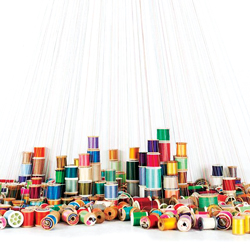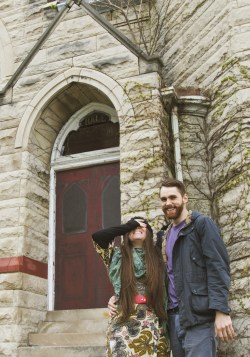A young couple’s repurposing of an old church is poised to fuel an international art movement.
When Earl Power Murphy decided to buy the old Hale Memorial Church at Main and High Street, he had big dreams. A Bradley University undergraduate student at the time, he walked regularly past the stately old church, enamored by its grandiosity and presence. After seeing the potential of the indoor space—and meeting a girl—a grand scheme emerged.
Natalia Villanueva was a third-year student at the École nationale supérieure des Beaux-Arts in Paris, France, when Murphy arrived on a two-week study abroad program. When their paths crossed, the connection was immediate. Though it rained every day for the remainder of his visit, the two spent each afternoon walking the city, happily soaked, hand in hand.
“Then… he left,” Villanueva recalls. She jokes of attempts to fit herself in his luggage, but the couple was realistic; he had goals to achieve in life, and I had mine, she explains. As a student immersed in the visual arts, her program was demanding. “Maybe later we’d meet again.”
Long-Distance Romance
Just a few weeks after he left, an opportunity arose when Villanueva discovered she could apply for an exchange program abroad. At first set on Japan or New York City, Villanueva shifted gears to follow her heart, settling on the School of the Art Institute of Chicago for its proximity to Peoria. The two reconnected there for a semester, then the relationship turned to Skype.
“It was seven months apart, three months together, then five months apart,” Villanueva details. “We kept that up for two years.” During that time, Murphy pitched his idea.
“He showed me a picture [of the church] and asked, ‘What do you think of buying this with me?’” While some might have thought him mad, Villanueva—an artist to the core—absolutely loved the proposal. Murphy suggested she could make giant installations, joking that she could have the entire space to herself. Whether inspired by that crazy idea or their crazy love, the happy couple married in 2010, and after another year apart—during which Villanueva worked on two extensive exhibitions in the Palais des Beaux Arts, a museum in the heart of Paris—she made the move to Peoria.
Diamond in the Rough
“When we bought it, we didn’t really think, ‘Oh, let’s make a cultural center!’ Villanueva explains. But the idea to fill the space developed over time. “It evolved [from] an understanding of a space… for celebrating music, friends and community,” adds Murphy, “into the entire spectrum of the creative experience.”
The church’s layout would seem conducive to the idea. A small stage in the basement is “meant for music,” says Villanueva; the main floor’s great room is ample for large crowds and artwork; and a sizeable balcony serves as additional versatile space—a magnificent locale for a grand cultural center. But peeking into the church today, this vision might seem a stretch from its current state. For starters, it needs a new roof. Two years ago, a large fire ripped a gaping hole through the floor, while birds and other former tenants have also left their mark. “There’s a bunch of debris that just needs to go,” Murphy explains.
With that in mind, the couple’s primary goal is to “bring the building itself to life”—rehabilitating it into a “functioning, welcoming, safe and habitable” state. Last May, they launched a campaign through indiegogo.com to raise funds for restoration and maintenance work. With over $9,000 raised, they have enough to get started. A company and bid are already secured for the roof, and the pair is now assessing next steps for repairing the floors and doors. “Right now, it’s a shell,” Murphy says. “I like the term ‘repurposing’ rather than ‘restoring.’ It will be a historic building that functions and operates on today’s standards.”
 Fostering an International Community
Fostering an International Community
The next goal is to fill the space. “Since the beginning of the project, we’ve been creating a collective—a community of artists,” Murphy says. As Villanueva has shared her work around the world, from Paris and Madrid to Lima and Los Angeles, she’s also kindled passion for the church. “We’ve invited many of these people to Peoria. They believe in our project.” Indeed, the artist Coralie Maurin came to Peoria from France to create a short film for the Indiegogo campaign, while others have created a range of art to support the project. The enthusiasm of this community, both locally and abroad, is the impetus behind the organization’s name: Yaku, a Quechuan word meaning “water.”
“We like to think of the church as a seed,” Murphy explains. “All the people who join us are like the water that helps it grow… The organization itself is really just a collective of people—that is the water that, when functioning together, creates this life. This life will primarily take form within the building.”
But first, they must stop the water from flowing into the building—literally. “There’s already too much yaku!” laughs Villanueva, describing the holes in the roof. But once the building is ready, Yaku plans to host two major festivals a year—one inspired by local themes and one sharing an international perspective. The local festival will feature stories of found objects told in new ways, highlighting different perspectives of what is already known locally.
Meanwhile, the international festival will be fueled by a call for proposals from artists around the globe to come to Peoria, learn from our culture and present their work at the church. Villanueva and Murphy envision Yaku as a bridge for developing a cultural and creative exchange of perspectives. “We want to invite people who… don’t know the Midwestern mentality,” Murphy explains. “Bringing [them] here to participate in events that introduce people to these other ways of seeing life through the creative experience… whether it be giant installations that fill the whole building… or a musical movement, performance, or something you physically participate in… There’s a broad spectrum of mediums we can use to facilitate that exchange.”
Villanueva is enthusiastic about the potential for launching an international artist residency program—an idea she recently pitched to a receptive team at her alma mater in Paris—and they’re excited by the prospect of sending artists from France to Peoria each year on two-month student visas. “They’d have a place to live and work, and bikes to get around the city,” she explains. “They’d leave with a taste of the city… and they will always talk about it.” That could have lasting benefits, she suggests. “The business world knows Peoria for Caterpillar, but… we want to make the international art world know Peoria through the church.”
 Up for the Challenge
Up for the Challenge
The enormous task of launching Yaku isn’t daunting to Villanueva and Murphy, who both seem to thrive under the weight of fulfilling lofty dreams. As a child growing up in Peru, Villanueva’ artistic ambitions weren’t always understood.
“For some people, being an artist meant being a painter,” she smiles. “It meant being Leonardo da Vinci or Rubens or Picasso. It was like, ‘Oh, you’re going to be Picasso? Hahaha. You’re going to be a starving artist.” Still, she held onto her “outlandish” dream—to attend fine arts school in Paris—and worked hard to make it happen. At the École nationale supérieure des Beaux-Arts, she specialized in visual arts, developing an understanding of space.
“The types of work I do, I would call them ‘moments,’” she says. “I create giant or tiny moments… most of the time I use materials you can find in your everyday life. I transform them with repetitive gestures and effort to awaken the viewer’s curiosity.
Villanueva’s work is primarily installation-based, Murphy explains. “If you think of an art gallery, it’s usually white walls, white ceiling, grey floors and sterile lights. The space is pretty much erased. Then on the wall, there’s a painting, or something like a sculpture in the middle of the room… In installation work, the piece is built to the space. So rather than… focusing on one element, the entire space becomes the element.”
Some of Villanueva’s previous installations were large enough to take over a room and consume all perception, physically enveloping viewers so they become a part of the piece themselves. “You have to consider everything as space—the weather, the people, the smells, the colors, the size… and the works are made related to the space,” says Villanueva.
Murphy, too, enjoys a challenge. At District 150’s Woodruff Career and Technical Center, he teaches a classroom of K-3 students who were all asked to leave their former classes for disciplinary reasons. His passion for teaching runs deep; future plans include a PhD with a focus on curriculum and school development. Describing how their plans fit with what’s become a second full-time job with Yaku, he explains, “We’re happy to be the founders and organizers and bridgers… but the idea is that Yaku is a community-organized foundation.” While they will stay closely involved, the couple hopes community engagement will lead to a multi-generational platform, with infrastructure and values easily passed on to others as leaders and participants.
Engaging the Flow
Villanueva and Murphy are busy with plans for a series of “teaser” installations before Yaku holds its first large festival in a few years. The two are purposefully vague on the details of upcoming artwork, adamant that everyone experience the moments for themselves, but they promise that “when it happens, it will leave quite an impression.”
They hope these teaser installations will give Peoria a taste of what Yaku plans to offer and build credibility for long-term support. “We have the people, we have the place, we have the will… We just need the financial support,” says Villanueva. “[Yaku] already has international support… We want to create a balance so people in Peoria know about it, too.”
Murphy says one of Yaku’s greatest challenges is how best to introduce this new international spirit and arts movement to Peoria. Numerous efforts continue to help their cause—from the growth of First Fridays to the redevelopment of the Warehouse District to recent projects along Main Street. “A lot of it has the same goals in mind,” he says.
“The local community has been very supportive,” adds Villanueva. “They always create room for this project because it’s a building that’s been a part of their lives… They want to see it happen. They know, too, that the organization is bringing something that’s never existed in the city.
“Not everyone’s attached to art, and not everyone has art in their lives—that is who we are working for. We want to create an environment that is welcoming to all, one that makes the creative and aesthetic experience inviting. We know there’s a large amount of people who would like to participate, but don’t know how. We’re building a platform for people who really want to engage in the evolution of culture in their city.” a&s
To learn more about Yaku, visit yakupeoria.org.


